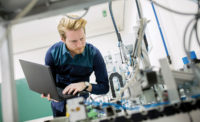ANN ARBOR, MI-(Story viaEdmunds Auto Observer ) Early in 2010, a number of safety-related recalls and the unintended-acceleration crisis found Toyota Motor Corp. president Akio Toyoda testifying to the U.S. Congress. Toyoda admitted his company’s practice of making decisions about recalls and other safety concerns only in Japan had contributed to a culture of ignoring customer input that may have prevented some of the problems. Toyoda said he said he would insist on a new culture of “customer safety first,” and pledged to create an automotive center of excellence in the U.S. dedicated to improving safety.
This week, Toyoda put his company’s money where his mouth was, as Toyota detailed a 5-year, $50-million commitment to a variety of collaborative safety research projects and brought some of its new safety-research partners and the media to tour a sprawling new $38-million technical center near Ann Arbor, MI, built to enhance the company’s safety-testing capabilities. Toyota engineers at the company’s Collaborative Safety Research Center will deploy on ten new projects with six different universities and research institutions to advance safety understanding and develop and test new technical innovations. The time span for the projects is 2011-15, but Toyota said one difference from its past practices is that it intends to disseminate much of what is learned, as opposed to its prior practice of conducting mainly proprietary safety research. The company said it also may announce additional research projects and partners in the coming year.
The 10 newly established safety-research partnerships run a wide range of disciplines, from a program with the Massachusetts Institute of Technology to study the distraction potential from new voice-directed onboard functions to development with Wake Forest University of a more-comprehensive accident-reconstruction method using Toyota’s sophisticated modeling of human body structure. Other research efforts include projects to improve safety for children and a program to evaluate and improve driving behavior by teenagers, which researchers here say remain a disproportionately at-risk group despite declining accident rates for the broad teen population.
Another study project will evaluate new safety aids such as radar-based accident-avoidance systems and lane-departure warnings. These so-called “active” safety systems are being evaluated because of their great potential, researchers here say, to reduce or even eliminate accidents between vehicles or with pedestrians. As part of the project, Toyota will participate in wide-ranging study of vehicle-to-vehicle and vehicle-to-infrastructure communications that promises, in addition to avoiding accidents, the potential to enhance fuel efficiency by coaching drivers for the correct speed to avoid red lights.
Near Ann Arbor is Toyota Technical Center’s York Township campus, opened in July, 2008, which among other things houses what currently is one of the continent’s most-advanced crash-test facilities. Toyota can accelerate vehicles as large as the Sequoia SUV to as much as 56 miles per hour for any manner of crash test except for rollovers. But the site also houses scores of engineers for vehicle and powertrain development for the models in which the company’s North American operations have direct responsibility, including the Tundra pickup, Sienna minivan and RAV4 EV, which is being co-developed with electric-vehicle specialist Tesla Motors.
Get our new eMagazine delivered to your inbox every month.
Stay in the know with Quality’s comprehensive coverage of the manufacturing and metrology industries.
SIGN UP TODAY!Copyright ©2024. All Rights Reserved BNP Media.
Design, CMS, Hosting & Web Development :: ePublishing


